Honda Insight (2001)
Honda Insight (2001) |
|
|
The Honda Insight is currently the second best hybrid vehicle on sale in the United States. We should also mention that there are only two hybrids in that category. The other is the Toyota Prius. We can sum up the differences between the Insight and Prius this way: The Insight is a vehicle for people whose first and foremost goal in life is to get the best possible gasoline mileage, everything else be damned. And the Prius is a great little car that happens to get outstanding gas mileage. In our opinion, the Honda Insight goes too far in making sacrifices in the interests of fuel economy. It has room for only one passenger, lacks space to put luggage or the groceries, rides harshly and loudly, and is tiny in comparison to everything else on the highway. Its shortcomings are particularly glaring in contrast with the Prius -- a comfortable, practical, high-mileage sedan that lets you have your tree and hug it, too. Honda's small, two-seater uses a hybrid gasoline-electric engine and gets a remarkable 68 EPA estimated mpg on the highway, and 61 mpg in the city. With a cars.com target price of $20,500, the Insight is about $1,100 less expensive than a Prius. The Insight was introduced last year, beating the Prius to the market by a year. And, it turns out, being first has its public relations advantages. The Insight's combination of technology and stratospheric gas mileage earned it the first-ever product award from the Sierra Club -- not an outfit particularly noted for filling automakers' showcases with trophies. Here's how the Insight works: The Insight's primary source of power is a 67-horsepower, three cylinder, one-liter gas engine. When additional power is called for, such as during acceleration, or driving up a hill, the 13-horsepower electric motor also comes on. To save gasoline and reduce emissions, the gas engine shuts itself off when the car comes to a stop, and restarts automatically when you depress the clutch. Unlike the Prius, the Insight never runs on its electric motor alone. The driver never has to think about any of this. It's all controlled by a computer. And because the batteries are recharged by the gasoline engine and energy that's recouped from braking, you never have to plug it in (so you can return that fifty mile long electric cord). Right now, the only transmission available is a five-speed manual. Honda says it plans to offer a fuel-saving, continuously variable automatic transmission later in 2001. |
|
 |
So, how well does all this technology work? Pretty well, actually. Driving around town, at speeds of up to 20 miles per hour, Tom thought the Insight accelerated adequately. That's because when you step down hard on the gas pedal, the DC motors kick in for additional torque. Dougie, on the other hand, said it reminded him of driving a 1975 Subaru, in both sound and performance. On the highway, at a steady 55 miles per hour on a flat road, we noticed that the Insight didn't need to use its electric motor -- but if you needed to accelerate quickly, the electric motor didn't seem to help much at that speed. We found there was no more power left to give. Although its technology allows the Insight to keep up with traffic, there's just no getting away from the fact that this is a very small and dangerous vehicle -- especially in comparison to the average Camry or Taurus, to say nothing of a Ford Excursion. Not only is the Insight small, but it's also got an aluminum body, which is very light -- the whole car weighs a measly 1,856 pounds. (By contrast, Toyota's Prius weighs 2,878 pounds, and Honda Civic coupe weighs in at 2405.) The Insight feels every bit as small as it is, and we felt exceptionally vulnerable while we were behind the wheel.
Because the Insight has significantly less mass than your average vehicle, it also suffers from horrendous, deafening road noise. Simply put, there's less material to absorb noises. In fact, we thought the noise level was unacceptably high -- and we were test driving a brand-new car. We shudder to think what the Insight would sound like in five years. |
 |
When Tommy first drove the car, he noticed that our producer, Doug Berman, had left it with its battery about three-quarters charged. That made us wonder if doing a lot of city driving, which places a high demand on the electric motor, would drain the battery. However, after 20 minutes of driving, about half of that at 50 miles an hour, the battery was up to 90 percent of a full charge. So, the batteries in the Insight seem to recover fairly quickly. Unfortunately, there's no switch for turning off the passenger-side airbag. If you want to carry a child in the passenger seat, you'll need to have an airbag switch installed by a Honda dealer. Anti-lock brakes, power locks, windows and mirrors, an AM-FM stereo cassette player, a trip computer and alloy wheels are standard. The only option available is air conditioning, which will run you another 1,200 bucks. |
 |
|
 |
The Insight looks like a miniaturized version of the old Citroens, with a very aerodynamic shape that tapers toward the back. This makes for a huge back window...with an effective cross section of only about two inches. Honda did do something cute, however: they put glass in the vertical section of the lift gate, which gives the driver a view of little kids standing right behind the car. It also provided a good view for the dog when she was lying down back there waiting for us to come out of a store.
|
 |
Who knows how reliable the Insight will be? There's a lot of technology in there. The electric motor, for example, uses new technology and is only two inches thick (about as thick as Tommy's skull). And all that technology is packed in very tightly. We raised the hood, we couldn't even see the electric motor. The Insight is too new to have a reputation. We'd guess that some of the risk is offset by Honda's sterling reputation for reliability. Plus, much of the car is still traditional "car" technology. So not all of it unfathomable. Honda offers the Insight with its standard three-year, 36,000-mile warranty, and an eight-year or 80,000 mile warranty on the batteries. In comparison, the Prius offers an eight-year, 100,000-mile warranty on the battery and hybrid components, including the gas engine. The rest of the car is covered by Toyota's traditional three-year/ 36,000 mile warranty. One note of concern: everything on the Insight is very lightly constructed, again, to maximize gas mileage. The undercarriage looked flimsy to us, and the axles look like strands of spaghetti compared to most cars. From a mechanic's point of view, the Insight looks almost like a kiddie car. |
 |
Except for the powertrain, everything else on the Insight is the same as a conventional car. You can go anywhere you want for service on parts like mufflers, brakes and tie rods. The drivetrain and the electric motor, however, will need to be serviced at a Honda dealer. |
 |
The Insight makes too many sacrifices in the name of efficiency, in our opinion. Compared to the Prius, you'll be getting an average of an additional 16 miles to the gallon. That might save you a few hundred bucks a year in gas costs, if you drive about 20,000 miles annually. Is that worth the loss of comfort, safety, quiet and interior space? We sure didn't think so.
View cars.com model report on this vehicle. |
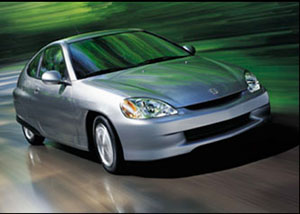
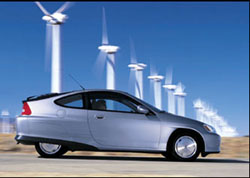 There are two other consequences of the Insight's very light weight. First, it blew all over the place in the wind. At 50 miles an hour, with a cross wind blowing, we felt as though we might get tossed into the next lane at any second. It was frightening.
There are two other consequences of the Insight's very light weight. First, it blew all over the place in the wind. At 50 miles an hour, with a cross wind blowing, we felt as though we might get tossed into the next lane at any second. It was frightening.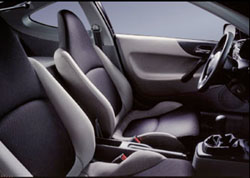 We've never been big fans of the coupe body style. As anyone with kids, or dogs, or shopping bags knows, it's a pain in the kiester to schlep things in and out of the back. Well, the Insight may be the epitome of coupes. It doesn't even have a back seat -- just a very shallow storage area that won't hold much of anything. Why is it so shallow? Because the Insight has a heap of batteries, right under the floor behind the seats. As a result, there's no trunk. The space that remains is further impinged by the steep, aerodynamic slope of the rear window. Even the dog had to squat down to fit.
We've never been big fans of the coupe body style. As anyone with kids, or dogs, or shopping bags knows, it's a pain in the kiester to schlep things in and out of the back. Well, the Insight may be the epitome of coupes. It doesn't even have a back seat -- just a very shallow storage area that won't hold much of anything. Why is it so shallow? Because the Insight has a heap of batteries, right under the floor behind the seats. As a result, there's no trunk. The space that remains is further impinged by the steep, aerodynamic slope of the rear window. Even the dog had to squat down to fit.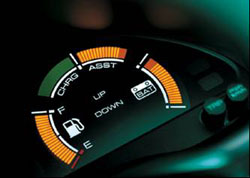 On the dash, Honda has given the driver a peek into the workings of its hybrid technology, with gauges that show when the electric motor is helping out, when the batteries are being charged, and how much juice is left in them.
On the dash, Honda has given the driver a peek into the workings of its hybrid technology, with gauges that show when the electric motor is helping out, when the batteries are being charged, and how much juice is left in them.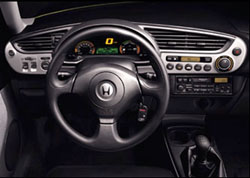 Ergonomically, the Insight is pretty straightforward. We particularly liked the radio controls, which, unlike those in many cars, don't require an advanced degree in electronics to operate. We do have to quibble, however, with the fan speed control. To raise the fan speed, you press the "up" button. So far, so good. To lower the fan speed, you just -- keep pressing the "up" button until it goes past the maximum and back around to low. Pretty lame, in our opinion.
Ergonomically, the Insight is pretty straightforward. We particularly liked the radio controls, which, unlike those in many cars, don't require an advanced degree in electronics to operate. We do have to quibble, however, with the fan speed control. To raise the fan speed, you press the "up" button. So far, so good. To lower the fan speed, you just -- keep pressing the "up" button until it goes past the maximum and back around to low. Pretty lame, in our opinion.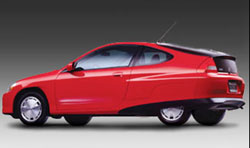 In terms of styling, Tommy loved the looks of the Insight.If you're comparing the Insight to the Prius, well, there's no comparison. The Prius is sensible shoes, while the Insight is stiletto Birkenstocks.
In terms of styling, Tommy loved the looks of the Insight.If you're comparing the Insight to the Prius, well, there's no comparison. The Prius is sensible shoes, while the Insight is stiletto Birkenstocks.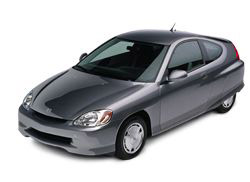 But, if you like being in the vanguard on new technologies, want to announce to the world that you're doing your part for a cleaner environment, have a smallish dog, and only need a car for commuting back and forth to your job in the city, the Insight may be a practical vehicle for you. With only two seats and so little storage space, though, we don't expect the Honda Insight to ever be more than a second car or novelty car in most households. But watch for future versions of this car. Honda has a habit of learning from its mistakes and coming back with vastly improved vehicles. See the
But, if you like being in the vanguard on new technologies, want to announce to the world that you're doing your part for a cleaner environment, have a smallish dog, and only need a car for commuting back and forth to your job in the city, the Insight may be a practical vehicle for you. With only two seats and so little storage space, though, we don't expect the Honda Insight to ever be more than a second car or novelty car in most households. But watch for future versions of this car. Honda has a habit of learning from its mistakes and coming back with vastly improved vehicles. See the